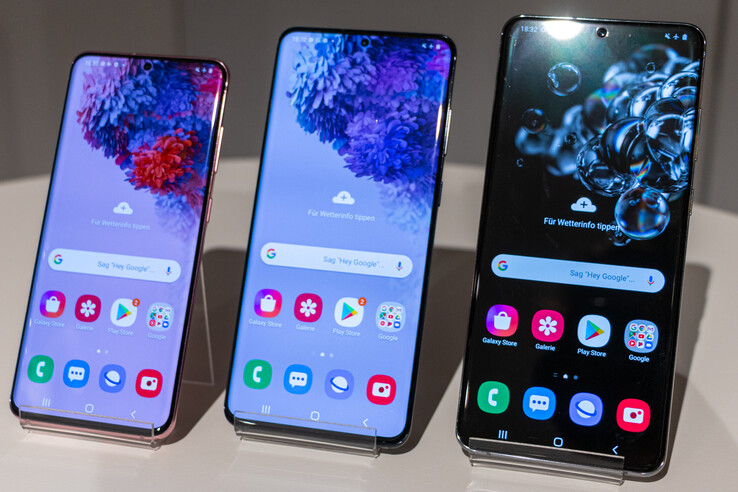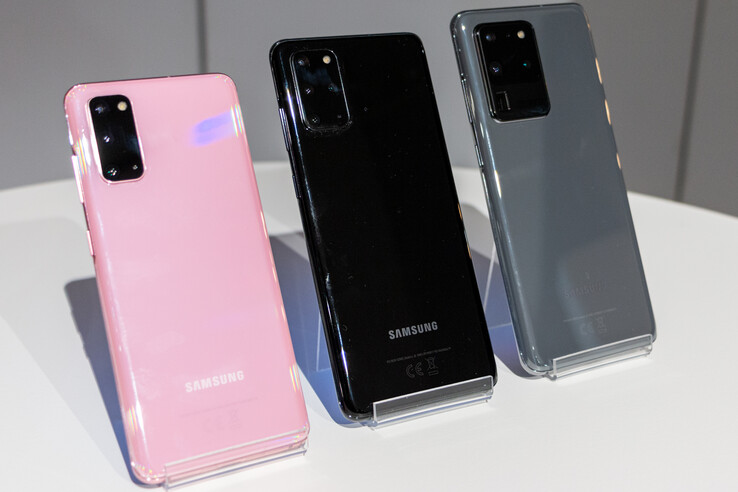First Impressions: Samsung Galaxy S20 Series Hands-On
Last Tuesday Samsung’s Galaxy S20 series was officially introduced to the public. Given that pretty much all details had already leaked in advance there were not really any surprises or big revelations. That said, the entire thing only starts making sense when you get to hold the smartphone in your hands for the first time.
As expected, there are once again three models. Unlike previously, there is no e-model anymore but instead another high-end SKU positioned above the S20 Plus called S20 Ultra. Accordingly, the starting price increased to $999.
All three models differ not only in screen size, but also in battery size, camera settings, storage capacity, and available colors. See the following table for a detailed side-by-side comparison. Once again Samsung is rather conservative in regards to colors, and the rule of thumb is the more expensive the fewer choices are available. For example, the top model equipped with 512 GB of storage is available in any color so long as it is black.
Differences Galaxy S20 Series
| - | Galaxy S20 | Galaxy S20+ | Galaxy S20 Ultra |
|---|---|---|---|
| Display size | 6.2 inch | 6.7 inch | 6.9 inch |
| RAM | 8/12 GB | 8/12 GB | 12/16 GB |
| Internal storage | 128 GB | 128/512 GB | 128/512 GB |
| 5G | optional | optional | yes |
| Wide-angle camera | 12 MP (1/1.76", f/1.8) | 12 MP (1/1.76", f/1.8) | 108 MP (1/1.33", f/1.8) |
| Ultra wide-angle camera | 12 MP (1/2.55", f/2.2) | 12 MP (1/2.55", f/2.2) | 12 MP (1/2.55", f/2.2) |
| Telephoto camera | 64 MP (1/1,72", f/2.0) | 64 MP (1/1.72", f/2.0) | 48 MP (1/2.0", f/3.5) |
| Depth-of-field camera | - | yes | yes |
| Max. zoom | 12x | 30x | 100x |
| Front-facing camera | 10 MP (1/3.24", f/2.2) | 10 MP (1/3.24", f/2.2) | 40 MP (1/2.8", f/2.2) |
| Battery | 4,000 mAh | 4,500 mAh | 5,000 mAh |
| Dimensions (L x W x H) | 151.7 x 69.1 x 7.9 mm | 161.9 x 73.7 x 7.8 mm | 166.9 x 76.0 x 8.8 mm |
| Weight | 163 g | 186 g | 220 g |
| Color options | black, gray, pink, blue | black, gray, blue | black, gray |
| Price (MSRP) | starting at $999 | starting at $1,199 | starting at $1,399 |
Strong Base for Galaxy S20 Smartphones
European Galaxy S20 SKUs are equipped with Samsung’s in-house high-end Exynos 990 SoC, which is manufactured in a 7 nm EUV process and feature an onboard dual-core NPU. Graphics are handled by an ARM Mali-G77 MP11 GPU, and all SKUs are equipped with LPDDR5 RAM and fast UFS 3.0 storage.
The Ultra model as well as all other 5G SKUs are equipped with a dedicated Exynos 5123 5G modem. Not only does it allow for high data rates, but it also finally introduces Dual SIM capabilities to the Galaxy S20 series. In order to maintain the optional microSD storage expansion slot, the Korean OEM has opted for a combination of Nano SIM and eSIM. Supported cellular frequencies have been expanded for 5G and are supposed to be plentiful once again. Further details were not yet available, though.
The remaining communication modules look more or less unchanged, at least in theory. Ant+ support is still included, as is Wi-Fi 6 and Bluetooth 5.0. We should note that the latter is not state of the art anymore.
The display technology is also identical in all three SKUs. Samsung’s Infinity O display is still based on Dynamic AMOLED technology, but compared to previous models the curvature along the sides has been reduced somewhat. Resolution remains user-adjustable and can go up to QHD+ (3200x1440, 20:9 aspect ratio). A new feature is the built-in 120 Hz mode that is supposed to improve smoothness. Unfortunately, it seems to be only available in FHD resolution despite the fact that you can enable both, QHD+ and 120 Hz mode, simultaneously. It is quite possible that Samsung will expand the availability of this feature with an update before the phone starts shipping. An either-or compromise between QHD+ and 120 Hz would not be fitting for a high-end smartphone such as this. We will have to wait for our extensive review to find out more, though.
Galaxy S20 Ultra, the all-encompassing Megapixel Monster
The biggest difference between the models lies in the cameras. While the S20 and the S20+ are more or less identical the S20 Ultra plays in its own league. The first thing we noticed is that the wide-angle lens no longer supports a variable aperture, but is fixed at f/1.8. In addition, the in-house sensors behind the telephoto lens have been upgraded to 64 MP (S20, S20+) and now allow for a powerful hybrid zoom. The Galaxy S20 supports a 12x zoom, the S20+ a 30x zoom, and the S20 Ultra’s space zoom up to 100x. Samsung does not disclose the telephoto’s optical zoom capabilities separately.
This zoom feature has been seamlessly integrated into the Galaxy’s camera app. In higher zoom levels a secondary picture-in-picture display pops up showing an overview over the entire scene, including the area that has been zoomed-in to (see screenshot). Please note that you will need a tripod to prevent camera shake should you intend to utilize these higher zoom factors.
Unlike the other two models the S20 Ultra features Samsung’s brand-new ISOCELL Bright HM1 108 MP sensor. Instead of four it combines nine pixels into a single super pixel, thereby reducing the effective image size to 12 MP. It is supposed to improve upon low-light photography, and we will have to wait for the full review to find out whether or not it is enough to show Huawei how it’s done. As our reviews of Xiaomi’s Mi Note 10 and Note 10 Pro, which both feature the HMX sensor, showed it is immensely important what lenses are installed in front of the sensor. Full-resolution photos are also supported. A mode called “single take” triggers all cameras simultaneously and produces up to 14 photos from which you can then select the best one.
The two higher-end models feature a separate lens for depth-of-field information. It is worth noting that this sensor is not just a pure DoF sensor, but also a 3D VGA camera.
Videos can be recorded in up to 8K (7680x4320) resolution. The front-facing camera supports up to UHD@60FPS, and all models include an auto-focus at the front. What separates the S20 Ultra’s front-facing camera from the other two is its larger sensor.
The few photos that we were able to take with the S20 smartphones turned out very well. However, it is too early for a final assessment, and we will have to wait until the first devices ship before we will be able to do so.
Preliminary Verdict – Galaxy S20 with Great Potential
Samsung has improved its flagship series quite extensively, and we can see that it has a lot of potential. The S20 Ultra in particular is designed to tackle Huawei and Apple head-on. In terms of form factor, we preferred the smallest model. Despite its large battery the Galaxy S20 has remained surprisingly small and lightweight, and Samsung has done a great job in this regard. It also offers the biggest variety of color options.
We will have to wait for our extensive review to find out whether or not the Galaxy S20 Ultra is worth its hefty premium, and whether its cameras are able to deliver what Samsung promises. We do expect the larger battery to last significantly longer. For European and Korean models everything will depend on the efficiency of Samsung’s new Exynos SoC. Its predecessor turned out to be less efficient than competing SoCs, and consequently the Exynos-equipped Galaxy smartphones offered a worse battery life than those with a Qualcomm SoC.
If you want to be one of the first to hold a Galaxy S20 in your hands you may want to consider to preorder. As a bonus, Samsung will throw in its brand-new Galaxy Buds+ TWS headphones for free. Unfortunately, this offer is limited to the two more expensive models.





























